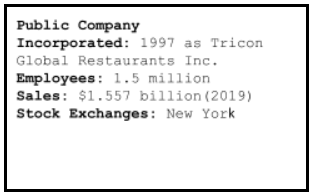Yum! Brands Inc.
Yum! Brands Inc
Found in 1997, Yum! Brands Inc. is one of the largest fast-food corporations in the world. They own over 50,000 restaurants in more than 150 countries. Based in Louisville, Kentucky, out of these restaurants about 3000 are company-owned and 40,000 are franchised. The company’s concept is to have a menu that emphasizes the preparation of food with a variety of ingredients. Moreover, it has recipes and special seasonings which make the food tastier. There are traditional and non-traditional units. The traditional units feature dine-in, takeout, and drive-thru or delivery service. Non-traditional ones have kiosks that have a more specific or limited menu and operate in non-traditional locations such as airports, train stations, colleges, and gas stations.
The company operates its business through six operating segments: YUM Restaurants China, YUM Restaurants International, Taco Bell U.S., KFC U.S., Pizza Hut U.S., and YUM Restaurants India.
Four of its restaurant brands, KFC, Long John Silver’s, Pizza Hut, and Taco Bell, are well-known companies that dominate the global market in chicken, quick-service seafood, pizza, and Mexican-style food categories.
Yum!Brands Inc Facts
In 2006, Yum! Brands generated more than $9.5 billion in total revenue. However, it was reported that in 2019 the annual revenue was $5.597 billion.
China Division is based in Shanghai, however, it has been reported separately due to its size, strength, and importance.
The company was once owned by Pepsi. Hence, Yum! Brands restaurants serve Pepsi products.
It gained seafood chain Long John Silver’s and beer chain A&W Restaurants in 2002.
China’s poultry scandal: KFC had a massive drop of 15% in 2013. Why did it happen?
In late 2012 Chinese officials revealed an investigation that KFC’s suppliers of chicken had a concerning level of antibiotics. Due to the scandal, KFC had to stop working with more than 1,000 suppliers and had to promise to improve its quality.
Taco Bell is the strongest domestic brand. Yum! Brands have invested in Taco Bell’s breakfast promotions as the chain has become the biggest brand in the United States. Pizza Hut holds down China whilst KFC is recovering.
However, what is Yum!’s overall global performance compared to its competitor McDonald’s. Yum! is a bit bigger than McDonald’s, since Yum has 43,000 restaurants whereas McDonald’s 38,000 restaurants. Although McDonald’s had its own ups and downs, still its global sales are better than Yum!’s.
Organisation And Companies
Yum! Brands, before becoming the fast-food giant it is today, had humble beginnings under PepsiCo. It was PepsiCo's restaurant division. In 1977 PepsiCo decided to acquire Pizza Hut so it could enter the restaurant business. In 1978, PepsiCo bought Taco Bell and followed by KFC in 1986. Yum! Foods Inc. was created in 1997 as Tricon Global Restaurants to manage the three major acquisitions PepsiCo had made as their parent company. In late 1997, Tricon Global Restaurants was spun off.
Spinning off is a type of corporate action where a company completely separates a business section as a different company or a second incarnation of the original company. Therefore Tricon Global Restaurants became a company in itself. Secondly, Tricon was created as a conglomerate. In Economics, a conglomerate is a company that has stakes in multiple smaller businesses all of whom conduct their business independently. Yum! currently owns KFC, Pizza Hut, Taco Bell, WingStreet, and The Habit Burger Grill.
Yum! Brands' marketing strategy is known as the 'skimming prices strategy'. Essentially it tries to offer a better ambiance and quality of food than its competitors, so customers will be attracted to its brand even though they are paying a higher price. Secondly, it tries to rapidly globalize and outsell the competition in foreign markets. And finally, it maintains a very aggressive advertisement strategy. Whenever one of its brands enters a new market, Yum! Foods will spend no expense in plastering brand advertisements all over that city, buying up the competitor's ad-space.
Yum!’s revenue in 2019 was $5.59 Billion. Including its major brands (KFC, Taco Bell, and Pizza Hut) Yum! is worth over $78.6 Billion.
Globalization
Yum! Brands' primary strategy is based on globalization. Globalization is the process of integration of people and companies all over the world.
Since Yum! Brands is a huge conglomerate, when it enters a new foreign market it immediately wipes out the smaller competition by pumping funds into advertisement, property acquisition, and buying up man-power. After the smaller competition is wiped out, Yum! concentrates on taking out larger local brands by harnessing funds from overseas ventures.
Yum! has become an unstoppable conglomerate precisely because of globalization. If it isn't succeeding in a country, it can always use revenues from its ventures in other countries to finance its campaign in another.
Via globalization and through free markets Yum! has established itself in China, India, all over Europe, South Africa, Egypt, and Thailand - just to name a few.
Yum! has become a massive and indomitable brand with the help of globalization.
Written by Aidana Assylbek and Rayandev Sen; edited by Alidar Kuatbekov.


